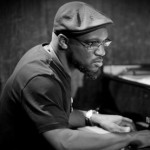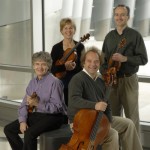Or, How I Learned to Stop Worrying and Really Like High On Fire
Fandom is the stuff of high drama. It demands a certain emotional immaturity, or a short-lived but full-throttle regression. We bond most closely with those bands and artists we discovered in our teens, follow them until the scales fall from our eyes, or they die, or break up, sometimes in the full noon of our love. If they don’t move on, we do. In either case, they become a yardstick for our development, allowing us to think of our lives in clearly-demarcated stages (“I used to be into x, now I like y”) and providing fodder for nostalgia (“Remember how great z was?”). Sometimes we move on because we think they’ve betrayed us, sold out. Growth is supposed to be organic, authentic, and artist-driven; selling out is artificial and market-driven. In fact, a band’s or artist’s growth is often figured as a sort of pilgrimage to authenticity, to the discovery of their “voice”; and this teleology allows us, the loyal fans, to map onto our own lives a similar sense of direction, purpose, and meaning under the aegis of art consumed. That said, the line between these two ostensible opposites can be blurry: one fan’s evolving artist is another’s sellout, and the latter fan may measure his or her own integrity by refusing the change. For those of us who stick with a band through their changes—and who, in that miracle of marketing, feel that a band has “stuck with us,” too—there are the purported rewards of growing old together.
The process of change over the course of a band’s career is often referred to as their arc. Career as fired projectile: trajectory and singularity, purpose and identity. Fractures and cobbles are smoothed into a seamless history. There is an implied normativity, too: the projectile is full of energy as it leaves the cannon’s mouth, reaches a peak—a state of equipoise between its native energy and the pull of the world against which it strives—and then falls. Bands run out of ideas, sell out. That sucking sound you hear is gravity.
But must the falling side of the arc be imagined as decay, as the projectile analogy implies? Let’s consider another career narrative, the traditional evolutionary model; perhaps it will give our projectile a little more life. Artists and bands—at least, first bands—often do begin full of naïve energy and unreflective passion, and follow with a period of expansion and experimentation, an adolescence full of straining and angst. The music becomes more and more complex, convoluted, self-conscious. In time, this reaches a breaking point, and from the break a new, simpler sound emerges: a sound, a voice that declares, finally, who this artist or band is. Simple, but no longer naïve or unreflective; the dynamic of complexity, gained from that period of experimentation, that journey to the self, is folded up inside it, like those extra dimensions in the string-theory universe. What appears simple is, for the careful—loyal, initiated?—listener, profound.
It’s probably no surprise to a habitual reader of this blog (?) that Rush is my template here. Consider the first decade or so of their 40-year career: from their beginning in the early ‘70s as a “Canadian Zeppelin” or Bad Company, to the Genesis/Yes-influenced period of 1975-78, to the British electro-pop/“world” music period between 1979 and the early ‘80s, at which point they (as the band tells it) “found their voice” and “became Rush.” For the purpose of illustration, the period from 1978 to 1981 is key. 1978’s Hemispheres was the most complex and Yes-ish in the band’s oeuvre. The first side is a six-part sci-fi rock-opera that actually continues a story begun on the previous album, A Farewell to Kings. There, the protagonist flew his rocket ship the Rocinante into the black hole Cygnus X-1. Here, he discovers the city of Olympus, and a society divided between mind (represented by the god Apollo) and heart (Dionysus). In the story’s climax, he brings balance to the world, figured in the sphere, and is re-christened Cygnus, god of balance. Now, a lot of people see Rush’s music as a whole as too much Apollo and too little Dionysus; Hemispheres is certainly their most Apollonian record, the peak of their Apollonian phase. It was, in fact, a breaking point, an odyssey of underworldly recording sessions. The Apollo-Dionysus conflict is a nice image for the band’s trajectory, and it might be said that their task post-1978 was to find that “perfect sphere” where the two impulses would be held in balance. Hemispheres is thus a prophetic record, charting a course for Permanent Waves (1980) and “The Spirit of Radio,” as these overly-regenerate Who fans found a way to bring the unregenerate three-chord brilliance of “Baba O’Riley” back into what was, after all, only rock ‘n’ roll.
One difficulty with using Rush as a template is separating pattern from history. Rush have always been a most protean and omnivorous band, and the shrinking and re-packaging of their sound at the turn of the ‘80s has as much to do with a response to the currents of the time as to their own maturing artistry. Other major progressive bands, like Yes and Pink Floyd and Genesis, similarly attempted to re-create themselves. But with the possible exception of Genesis, these bands’ heydays had come and gone—and Genesis did such an about-face by consolidating a poppier sound under the leadership of soon-to-be pop superstar Phil Collins that they seem only nominally equivalent, like Gilmour’s Floyd to Waters’. Yes split in two, one half combining with ELP to create something called Asia, a mildly embarrassing superproject, and very much the embalmed corpse of ‘70s prog rock. Then there was 90215: genial, radio-friendly, and about as much the Yes of Relayer as Asia. Only Waters’ Floyd succeeded in marrying the art-rock concept record to the radio single … then put out one more fraught record and promptly blew themselves to pieces. In sum, voices long-since discovered, these bands were on the falling sides of their arcs, pulled hither and thither by changing lineups, and working out of the crucible of punk reactionism. Rush, hidden away in the Great White North, listening to the signals of distant revolutions over their radios, the younger band by a little under a decade, were still on the restless upper climb when the ‘80s landed.
If we look after 1983 or so, to the parallel progressivism of underground ‘80s metal, for whom the classic and progressive rock bands of the ‘70s were as influential as NWOBHM, I think the evolutionary arc emerges more clearly from its historical circumstances. It is as though, once woven by history, a pattern becomes detachable, and able to be worn as a garment by future artists.* When Metallica moved from their magnum opus … And Justice for All (1988) to the more pared-back metal of the suggestively eponymous Metallica (1991), Lars Ulrich justified the change—which enraged so many loyal fans—with the words, “More than any other band, we are like Rush.” In fact, Ulrich described a breaking point not so different from the one Rush described with Hemispheres, in his case after playing the nine-minute title track live for the umpteenth time, and, if I remember correctly, stabbing his drumstick into one of the “lady justice” props on his way offstage (how symbolic!). This sort of piggybacking has more than a bit of self-promotion about it—we’re talking Ulrich here, after all. But then it wasn’t only Metallica. Many of the prog-metal bands I most admired from the ‘80s (Voivod, Queensryche; to a lesser extent, Iron Maiden) went through a similar evolutionary process, from a straight-ahead sound to a more experimental one, to a distilled, popular form.
This is all well and good for peaks. But the falling projectile still troubles me. The preceding discussion leads me to wonder whether a band’s achieving their voice really leaves them anywhere to go—whether the meridian isn’t also the onset of night, whether there is something vital and sustainable in that achievement, and whether other voices are possible, or at least other registers. Finding one’s voice might simply spell the end of something essential about a band’s life-cycle. This is precisely the case many have made about Rush: after the aesthetic and popular peak of Moving Pictures (1981), the band began a long downward slide, with a big dip at the end of the ‘80s and a spotty record since. Perhaps Floyd, or at least Roger Waters, did well to move on; perhaps Yes was right to continue re-configuring line-ups. Perhaps marriages, at least in rock ‘n’ roll, were never meant to last.
And yet, Rush has kept on changin’, whatever we might think of the quality of their output, and has managed to sustain and even expand their fanbase of 30 years ago. Clearly, a voice is a sound, not a style—Rush keeps dabbling in the latter despite the stability of the former.** If we imagine the peak as full maturity, or the achievement of identity, or self-understanding, is there something approaching wisdom, at least for some bands, when we look later in their careers? Perhaps we should ask a different question, one I suggested earlier: Does the listener have to be a fan, even a lapsed one, to really hear the later work? A year or two ago, a friend of mine who is a big Dylan fan floated me one of the bard’s more recent albums—I don’t remember which one—because he felt it had crystallized elements of Dylan’s art in a way that many weaker recent albums had not. I confess I couldn’t hear it; it sounded like bad Dylan to me. But my knowledge of Dylan ends with the major albums of the mid-‘60s and a few other well-known songs; my favorite of his records is still The Times They Are A-Changin’, for God’s sake. So how could I hope to understand what made this recent Dylan album different, special? In this way, consciousness of evolution—a sense of history—allows certain canons of knowledge to revolve around fan identities: what appears trite to the outsider is, in the context of an ouevre well-studied, profound; fidelity is rewarded by (presumed) insight, as the later works become runes interpretable only by the initiate.
It’s true that the evolutionary arc is a bit like Monty Python’s theory of dinosaurs: thin on both ends, thick at the middle. And from the emotional and intellectual gratification I receive, and from my vaunted academic training, it follows that I want to squeeze anything and everything I can into such a model … and when I can’t, to use the model to explain away anomalies. Even more, as the projectile implied, I want to use the model normatively, so I can judge the success or failure, authenticity or artificiality, completeness or incompleteness of a band’s career. It’s just so neat: the vulgar Hegelianism of it, simple-complex-“simple,” innocence-experience-wisdom, life-death-rebirth. And yet, for me, the neurotic fan, the reluctant follower, it begs the question of whether alternative models of evolution are possible, or desirable, and what it means as a listener to throw the template aside and embrace something completely different. And it begs the question whether it’s possible for a band not to evolve … and still remain vital.
*
 I first read about High on Fire in the Village Voice, of all places. This was back in 2005 or so, shortly after I’d discovered Mastodon, and HOF was listed along with them and Shadows Fall and Lamb of God as bands that were remaking contemporary metal. Now, HOF had long been paired with Mastodon; the bands had some joint early releases and tours, and their big, lumbering sounds had yoked them together in the “stoner rock” or “doom metal” sub-genre.§ In 2006, when Relapse bundled new versions of the songs on Mastodon’s “Lifesblood” (2001) and “Mastodon” (2000) EPs with material from their original demo, they bundled that with a sampler that included two tracks from HOF’s Blessed Black Wings. Based on these tunes, my first impression was of warmed-over Kill ‘Em All-era Metallica, with some reconstituted Sabbath and Motorhead dumped in. And so, for the following several years, I wrote them off.
I first read about High on Fire in the Village Voice, of all places. This was back in 2005 or so, shortly after I’d discovered Mastodon, and HOF was listed along with them and Shadows Fall and Lamb of God as bands that were remaking contemporary metal. Now, HOF had long been paired with Mastodon; the bands had some joint early releases and tours, and their big, lumbering sounds had yoked them together in the “stoner rock” or “doom metal” sub-genre.§ In 2006, when Relapse bundled new versions of the songs on Mastodon’s “Lifesblood” (2001) and “Mastodon” (2000) EPs with material from their original demo, they bundled that with a sampler that included two tracks from HOF’s Blessed Black Wings. Based on these tunes, my first impression was of warmed-over Kill ‘Em All-era Metallica, with some reconstituted Sabbath and Motorhead dumped in. And so, for the following several years, I wrote them off.
In hindsight at least, Mastodon and High on Fire make an odd pair. Like Metallica, Mastodon might claim they are “like Rush,” or maybe just “like Metallica”: from the punk-length, solo-less miniatures of the early work, through the crushing Remission, the proggy Leviathan and Blood Mountain and, to a certain extent, Crack the Skye, a title suggestive of that pinnacle/breaking point, and an album on which one can already hear the paring back to a more popular, anthemic, vocal-melodic style of The Hunter. Mastodon have clearly made the arc part of their identity, and, like the progressive rock bands of yore, expend a good part of their artistic energy in the self-reflective mapping of their career.
But High on Fire? They’ve been mired in a sound, the sound of sounds, since Matt Pike was roused from Sleep. They are the Neanderthals to Mastodon’s Homo sapiens. Evolution has never been the point. As with their career, so with their individual albums—two-speed bikes all of them—and songs, which work less through development than bludgeoning repetition. There’s no hiding here, either the band in their music or the listener from it. It has a single dimension, and it demands surrender.
Said surrender was never more apparent than at the Bowery Ballroom last winter, my sadly belated introduction to HOF live. I started out in the back, by the bar, a little skeptical, mildly disappointed. But the longer the show went on, the closer I got, wending my way song by song through the crowd; and the closer I got, the more my critical and rational faculties were beaten out of me, until, by the time the band ended with “Hung, Drawn and Quartered” and encored with “Snakes for the Divine,” I had no resistance left. The “stoner rock” and “doom” labels thus fit nicely, even mesh: music as inescapable as Fate, as the potsmoke-haze of distortion that envelops everything. At the Bowery, you could hear that distortion humming between songs; the amps sounded restless, twitchy, as if the music were a tiger hidden inside them, waiting to pounce.
Like his music, Pike is all of a piece—what you see is most certainly what you get. And what you get is ugly. It’s important, no, it’s essential that Pike be ugly. Pale, sweaty, bloated, tattooed, shirtless, snaggletoothed, strings of hair sticking to his face, guitar strapped to his body: he is metal’s answer to Stevie Ray Vaughan, and that dirty, sweaty, snaggletoothed sound he gets owes as much to his one-time Gibson Les Paul as SRV’s did to his Strat. (The other two, bassist Jeff Matz and drummer Des Kensel, are not bad stand-ins for Double Trouble; Matz even looks a little like a younger Tommy Shannon.) As for his voice, what would you expect it to sound like, coming out of that jagged hole of a mouth? It has that heart of a heart of a Gibson crunch, too, as if, by following each other so often, guitar and voice had come to be parts of a single instrument.
Pike. Even his name is a weapon.
The Bowery stage didn’t transform Matt Pike, or anyone in High On Fire. Or anyone in the crowd. At the Bowery, no one, nothing becomes beautiful. But then this is a music, a band, that tries with might and main to make a virtue of an aggressive ugliness. What’s amazing is how often it succeeds.
*
It was Snakes for the Divine (2010) that turned my ear to High on Fire, that made me want to turn back to the earlier records. There’s some sense in this. With the opening riff of the opening and title track, the album announces itself as more riff-oriented, more traditionally power-metal, than what I had heard previously. The songs as a whole are less chorus-averse, and sometimes even downright chorus-friendly, more invested in structure than droning repetition. The production on Snakes (and 2012’s De Vermis Mysteriis) is a little cleaner, too; the chord progressions are a tad less jagged and time-screwy than those on, say, Surrounded by Thieves (2002). These differences are probably what enabled Snakes to serve as a way “in” to the bands oeuvre. And yet, the idea that Snakes marks some new stage of growth, some new incarnation of High on Fire that more closely mirrors my taste, is impossible to sustain, since these differences are overwhelmed by the general sameness of a decade’s music. The pummeling, bludgeoning feel is as much in evidence on Vermis as on the debut Art of Self-Defense (2000) … to the point that any music critic who would grapple with writing about HOF has to dig deep into the Thesaurus to find new words meaning “to be hit with a blunt instrument.” The sound is still hugely oversaturated, with a humming layer of hyperdistorted bass, although, as noted, it has pulled back a little from the edges. Songs still regularly wander into the six-to-eight minute range, trading on a certain amount of droning monotony to get there, if (again) a little less relentlessly than a decade ago. Nor did the heavy riffing really start or stop at any particular moment; I can point to Snakes as having more of them, and “Snakes” as having the sort of über-riff that is worthy of video-game immortality; but Self-Defense is hardly riffless (cf. “Blood from Zion”). Even Death Is This Communion (2007), the band’s most “experimental” album (according to Pike), keeps experimentation firmly on the margins, as preludes, postludes, and interludes, hardly troubling either the typical bent of the songs or the overall sound. Thus, small differences of degree submerge occasional, tantalizing differences of kind.
I mentioned before that HOF is a two-speed band, either full ramming mode or smoke-clearing-after-the-battle rumination, menace, and self-regard. Of the two, I go for the lower gear, and a cross-section of such songs demonstrates both the essentally static nature of the band’s career and the subtle, and sometimes not-so-subtle, changes between records. “Thraft of Caanan” (2002) could be “Death is This Communion” (2007) could be “Through All Dark We Pray” (2010) could be “King of Days” (2012). All exhibit the doom sound in full regalia: the heaviness of Fate; the certainty of Death in the slow, tidelike motion of Time; or some other such statement ending with a capitalized, abstract Noun. It’s music that sounds smelted; you can hear iron and sweat, smoke and blood. Fuck, you can almost taste it. But within this essential continuity, differences: the jaggedness of “Thraft,” pared back to a near-hypnotic groove on “Communion”; the latter’s minimal riff extended on “Through All Dark” into something more Sabbath-flavored; while “King of Days” has the vibe of a heroin anthem from an old Alice in Chains record. Differences, yes; but never any sense that the band is building toward anything, that this series forms part of a growing edifice, where each album is a stone lain atop the last. With HOF, the edifice was there from the start; the band have just been exploring chambers within it, some a little more classical, some more modern.
Again, the contrast with Mastodon is illuminating. Mastodon build songs out of smaller parts, adding them together, and then trying to create bridges between parts, or just letting them jangle against each other, in either case hoping that they add up to something greater. This is seldom the case with High on Fire. They don’t build up and out; they dig down, mining the guts out of a single riff, burying themselves and us in their groove. With Mastodon, at least as late as Crack the Skye, you’re just getting a taste of a riff when they change it on you. HOF cram it down your throat until you choke on it. There are no sudden shifts, and sometimes no feeling that a chorus or bridge (insofar as they exist) is climaxing a song. Instead, what you feel is a vein exhausting itself: walls collapsing, oxygen giving out, tissue beginning to die. You can’t really like or dislike part of a HOF song—you either take it whole or don’t take it at all. It’s carved out of a single stone; its success or failure is integral, not additive.
That stone isn’t only the monotony of a single power-chord progression, or riff disguised as such, but of a sound: one that depends on voice and instruments all saturated and downbeat-pounding on that riff together. Listening in particular to the earlier albums, you sometimes get the feeling that the musicians have all found the same frequency, and that the recording is in the process of shaking itself to pieces. (Remember that movie we all had to watch in science class, of the suspension bridge coming apart, the roadway twisting like a sheet of cardboard, the cables snapping, the towers crumbling? Like that.) These are unfinished, half-emerged carvings in noise—noise feeding on itself, muddling everything into a hivelike, motoric drone.§§ Pike’s endearingly sloppy guitar playing only multiplies that overall noisiness: double-tracked solos a la Tony Iommi, big bends with a wavering semitone to grate against, speedy runs that feature a wildly-picking right hand.
Maybe one’s whole listening life isn’t about coming to terms with noise. Hell, maybe music is a way back to noise, and not the reverse …
Mastodon, then, are building a cathedral, crafting a legacy with a self-consciousness about and worshipfulness toward rock tradition befitting a prog-metal band. The idea of the quest, which has been with them through all their albums since 2004’s Leviathan, folds into the broader quest for a sound, a voice, and nicely into the Rushian arc. With Mastodon, one can’t really predict the next record from the last. Nothing could be less true for HOF. I’d as soon ask a record store clerk what the new High on Fire sounds like as ask a druggist how their latest shipment of aspirin is. Their career is a flat line, slope 0, with bumps and divots, hillocks and gullies. If we want to imagine anything like directional change—and I’m always looking for it, and making it up when I don’t find it—I would think not arc, but straight line with a negative slope. Let’s borrow a word from the band, redefined for our purposes: devilution. Here, perhaps, is the Cartesian equivalent of that mining I described earlier: a distilling, a purifying, an attempt to become yet more themselves, to dig down to the essence of something that has been present from the beginning, only in mixed form.*** That they seek this purity in dirt, in noise, is, I think, what makes them so interesting, and what keeps me listening.
* I don’t mean to imply that this template begins with Rush, or progressive rock more generally; it is clearly part of the way an artist’s career is measured against his or her life. But since a rather interesting idea has emerged, I’m going to let the discussion stand.
** It’s different for a band that reach their meridian and then stall, or for the band that achieve something toward the beginning of their career and then find they have nowhere else to go, no way to really build on that sound. In such cases, after a few iterations, we start to get the feeling that the band are performing themselves. Rage Against the Machine, Tool, maybe Living Color. Consider Tool: after they had fully achieved their sound with the brilliant Aenima, less by transformation than by organic expansion, the few subsequent albums—each longer-awaited and more elaborately packaged—added nothing to what they had done before. A few great tracks on Lateralus, and a couple of quite good ones on 10,000 Days. But those albums sound a little forced; the psychedelic, faux-Eastern, fractally-multiplying minimalist sound had already been perfectly realized; all they could do now was lard it. Of course, such an assessment is much influenced by the first album one hears by a particular band, as well as by the listening background that brings one to them. (By the way, that Rush were considering what it meant to be a band on the other side of a megahit like Moving Pictures (and their resilience in the face of this) is suggested by the chorus (and title) of “Marathon,” from Power Windows (1986): “From first to last/ The peak is never passed/ Something always fires the light that gets in your eyes/ One moment’s high/ And glory rolls on by/ Like a streak of lightning that flashes and fades in the summer sky.”)
§ For me, the pairing goes deeper. The Bowery Ballroom, the first place I saw High on Fire, is the same venue where I first saw Mastodon back in 2005, after waiting a very good hour in front of the sold-out club for the bouncer to grace me with a point and curl of the index finger.
§§ I may have parodied the idea of metal being a drug in “Vermis Odium” (02.11.13), but only because I am intrigued by metal’s (like all music’s) potentially therapeutic use; I’m actually still waiting to receive a scientific paper to this effect from a presenter at April’s Heavy Metal and Pop Culture conference. Seriously, there’s a reason I listen to Miles Davis on the way into work and Napalm Death on the way home. Distortion, noise itself, has to be therapy. Writing this post called to mind an experience my partner and I had while working in Spain as WWOOFers back in 2002. At one of the fincas, the proprietors informed us of a technique where one person lay relaxing belly up on the ground while another blows into a didgeridoo, moving the end of the instrument all around the person on the floor, about a foot away from their body. I don’t remember what the outcome was supposed to be, or whether I felt anything when it was done to me; but it was clearly intended to be therapeutic (relaxing? exciting?), and it strikes me that the sort of all-consuming distortion HOF trades in might have a similar effect on the listener. A vibrational purging, like those tractors with a vise on the front, that shake the ripe olives out of a tree at harvest.
*** Or perhaps I have stopped writing about High on Fire here, and started writing about Meshuggah?
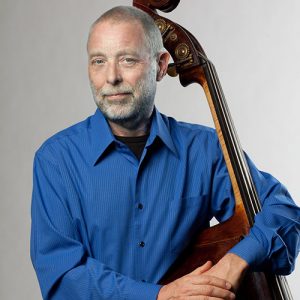 What to do when, returning from the restroom after the early set of Dave Holland’s quartet at Birdland, you find Mr. Holland himself occupying the bar stool next to yours? Sit there and fidget, of course. Allow the window of opportunity to close, and the guy sitting on his other side to grab his ear. Then, sulk into your coffee, thinking about all the things you could have been saying to Dave Holland.
What to do when, returning from the restroom after the early set of Dave Holland’s quartet at Birdland, you find Mr. Holland himself occupying the bar stool next to yours? Sit there and fidget, of course. Allow the window of opportunity to close, and the guy sitting on his other side to grab his ear. Then, sulk into your coffee, thinking about all the things you could have been saying to Dave Holland.
 Alto saxophonist Patrick Bartley, whose Dreamweaver Society sextet played the Gallery a few Thursdays ago, also fits nicely with either interpretation. On the one hand, he is the founder of the J-music ensemble, a cross of jazz with Japanese pop and the ur-popular (among younger folk) aesthetics of anime and video games. On the other hand, he boasts an impressive resume of sidework with jazz veterans like Mulgrew Miller and Wynton Marsalis, on the latter of whose HBO YoungArts Masterclass he appeared, to much acclaim. Recording by seventeen, a Grammy nomination already under his belt, Bartley is the model young lion. He even looks a bit lion-like in his photo on the J-music website, with neatly-arranged beard and dreadlocks: a contemplative, serious young man, staring meaningfully off at some horizon.
Alto saxophonist Patrick Bartley, whose Dreamweaver Society sextet played the Gallery a few Thursdays ago, also fits nicely with either interpretation. On the one hand, he is the founder of the J-music ensemble, a cross of jazz with Japanese pop and the ur-popular (among younger folk) aesthetics of anime and video games. On the other hand, he boasts an impressive resume of sidework with jazz veterans like Mulgrew Miller and Wynton Marsalis, on the latter of whose HBO YoungArts Masterclass he appeared, to much acclaim. Recording by seventeen, a Grammy nomination already under his belt, Bartley is the model young lion. He even looks a bit lion-like in his photo on the J-music website, with neatly-arranged beard and dreadlocks: a contemplative, serious young man, staring meaningfully off at some horizon.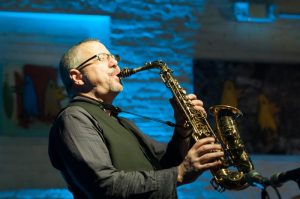 About an hour after listening to Bartley’s sextet at the Gallery, I walked in on a quiet little pow-wow at The Stone. It might have been a sobremesa in some old artist’s parlor that I suddenly found myself semi-eavesdropping on. Marty Ehrlich was among them, as I realized a little later on—unlike with Bartley’s band, there was no sartorial riser separating musicians from audience. I recognized him when he went over to his bass clarinet and played a scale, perhaps an illustration of something he was saying. It’s enough just to hear the rich, still unjustly rare tone of the bass clarinet in a space as small as The Stone to be entranced.
About an hour after listening to Bartley’s sextet at the Gallery, I walked in on a quiet little pow-wow at The Stone. It might have been a sobremesa in some old artist’s parlor that I suddenly found myself semi-eavesdropping on. Marty Ehrlich was among them, as I realized a little later on—unlike with Bartley’s band, there was no sartorial riser separating musicians from audience. I recognized him when he went over to his bass clarinet and played a scale, perhaps an illustration of something he was saying. It’s enough just to hear the rich, still unjustly rare tone of the bass clarinet in a space as small as The Stone to be entranced.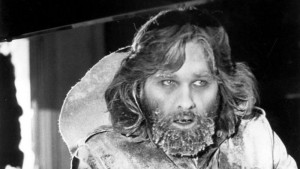
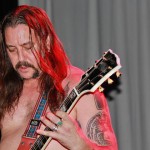



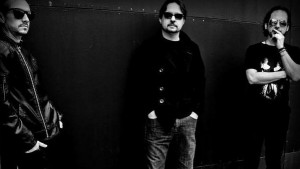
 The Sharks are a party band from Austin. They take a page out of Municipal Waste’s book—that I-was-a-shop-burnout/high-school-fuckup persona—although they’re too much a muddle of styles to worry themselves about reviving anything in particular. Actually, their music sounds like The Ramones wearing a metal skirt. Singer/bassist Mike Hardin, a big goofy teddy-bear of a guy, spins cock-and-bull yarns between songs about being the too-old loser living in his mom’s basement, meant to inspire moments of ironic reverie. Guitarist Will Ellis looks like a cross between the father from the original Hills Have Eyes family and Rudolf Schenker: blond, mustachioed, wearing short-shorts, and headbanging to the Scorpions records spinning away in that basement room in his head. He plays an upsidedown Gibson Explorer (at least the neck is), Hardin an upsidedown Fender Jazz—which, I guess, is a comment on how I’m supposed to take the Sharks: not seriously.
The Sharks are a party band from Austin. They take a page out of Municipal Waste’s book—that I-was-a-shop-burnout/high-school-fuckup persona—although they’re too much a muddle of styles to worry themselves about reviving anything in particular. Actually, their music sounds like The Ramones wearing a metal skirt. Singer/bassist Mike Hardin, a big goofy teddy-bear of a guy, spins cock-and-bull yarns between songs about being the too-old loser living in his mom’s basement, meant to inspire moments of ironic reverie. Guitarist Will Ellis looks like a cross between the father from the original Hills Have Eyes family and Rudolf Schenker: blond, mustachioed, wearing short-shorts, and headbanging to the Scorpions records spinning away in that basement room in his head. He plays an upsidedown Gibson Explorer (at least the neck is), Hardin an upsidedown Fender Jazz—which, I guess, is a comment on how I’m supposed to take the Sharks: not seriously. After American Sharks, how can any band, let alone one called Whores, appear as anything but Serious Music? They certainly looked more serious; singer/guitarist Christian Lembach (middle) is damn near clean-cut, in a punkish sort of way. Who knows but that they brought the Sharks along for sheer contrast, although more likely the two got really drunk together after their 2014 SXSW performances. It was certainly a Serious Comment Mr Lembach made partway through their set—unlike the Sharks’ truncated rambles, his were rather softspoken, and I missed a good half of what he said; but I did gather that they were happy to have good-time folks like the Sharks along with them on tour, that they were pleased to be back at Vitus, and that they didn’t sing about dragons and wizards—not that he had a problem with that—to each his own, it takes a rainbow, etc.—just not his scene. I wondered who this comment was directed at, if there was an errant Amon Amarth fan in the crowd looking at a subway map. Anyway, said Serious Comment disposed me to change my attitude, and Listen Seriously.
After American Sharks, how can any band, let alone one called Whores, appear as anything but Serious Music? They certainly looked more serious; singer/guitarist Christian Lembach (middle) is damn near clean-cut, in a punkish sort of way. Who knows but that they brought the Sharks along for sheer contrast, although more likely the two got really drunk together after their 2014 SXSW performances. It was certainly a Serious Comment Mr Lembach made partway through their set—unlike the Sharks’ truncated rambles, his were rather softspoken, and I missed a good half of what he said; but I did gather that they were happy to have good-time folks like the Sharks along with them on tour, that they were pleased to be back at Vitus, and that they didn’t sing about dragons and wizards—not that he had a problem with that—to each his own, it takes a rainbow, etc.—just not his scene. I wondered who this comment was directed at, if there was an errant Amon Amarth fan in the crowd looking at a subway map. Anyway, said Serious Comment disposed me to change my attitude, and Listen Seriously.
